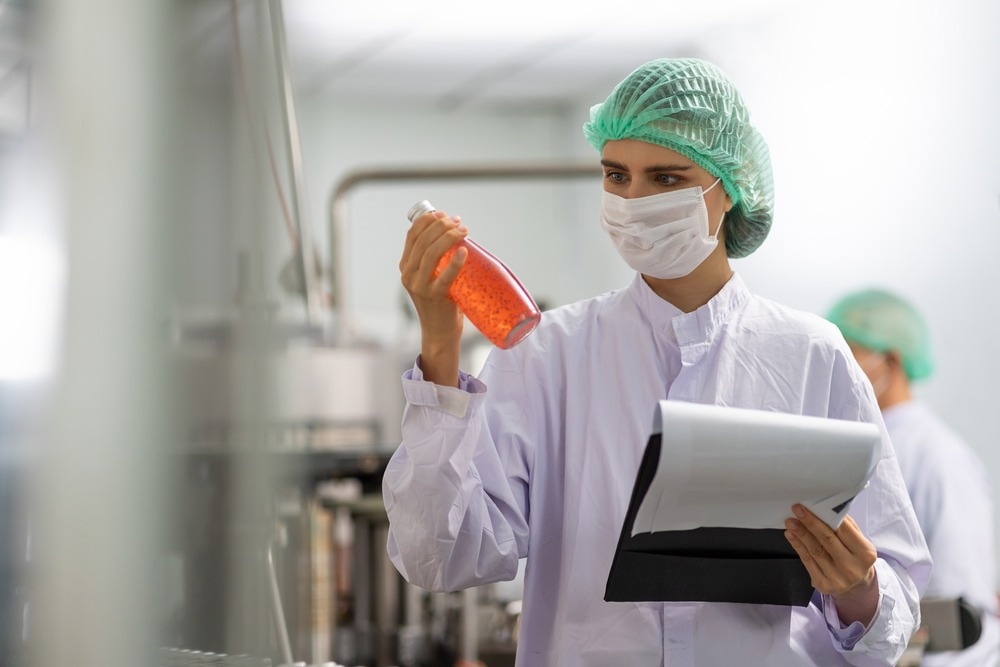In this article, the role of electrospun nanofibers in beverage filtration applications is discussed in detail, along with fabrication methods and relevant examples from research.

Image Credit: Amorn Suriyan/Shutterstock.com
Defining Electrospun Nanofibers
Electrospinning is a simple process of manufacturing nanoscale polymer fibers without high temperature or pressure. In this process, the polymer solution or melt is turned into nanofibers under high voltage.
In a conventional electrospinning device, a solution or melt is placed in a syringe. The negative terminal is connected to the receiving device and the positive to the spinning solution. The external electric field is applied to the droplet at the nozzle opposite the surface tension direction. A gradual increase in electric field overcomes the surface tension, and the droplet changes its shape firstly to a conical shape known as the "Taylor cone", and after that, upon the increase of electric strength to a critical value, Taylor cone forms a jet. This jet is deposited on the collecting plate forming electrospun nanofibers.
Applications in the Beverage Industry
One of the most prevalent methods for removing suspensions and other components that may alter the quality of a beverage is filtration. Using electrospinning to create nanofibrous films with high porosity, linked pores of tiny diameter, and a large specific surface area has garnered considerable interest within the beverage filtering industry.
Electrospun nanofibrous films are now tested in the beverage sector, namely in producing fruit juice and beer. As discussed below, there are several ways to apply electrospun nanofibers for beverage filtration.
Polyethylene Terephthalate Nanofibrous Membrane (PET ENM)
Initial research has explored the use of a polyethylene terephthalate nanofibrous membrane (PET ENM) for apple juice filtering, demonstrating promising results. PET ENM's juice flow was twenty times greater than the juice flow of the ultrafiltration membrane, and its operating pressure was seventy times lower than the pressure of the ultrafiltration membrane. Aside from that, the physicochemical parameters of both juices produced by PET ENM filtration ultrafiltration were identical and met the required standards.
Electrospun Nylon-6 Nanofibrous Membranes (NFM)
Ideally, the antioxidant qualities of the juice should be preserved. At the same time, the ability to remove phenols is enhanced during juice processing to preserve the nutritional value of juice while improving shelf life and stability.
Antioxidant properties of apple juice are not influenced by nanofiber membranes like electrospun nylon-6 nanofibrous membranes (NFM) as filter media. The filtering ability of NFM oxygen radical absorption membranes is comparable to that of commercial polyamide membrane filters.
Membrane filtration is essential for removing microorganisms from drinks. Researchers tested electrospun NFM membranes for their capacity to remove yeast cells and bacteria from beer, and isothermal calorimetry validated their efficacy.
Addition of Enzymes
Adding enzymes to the fiber membrane surface is a typical way to increase its filtering performance. Enzyme immobilization can be achieved by the electrospun nanofibrous film. It is possible to increase the amount of enzyme that can be immobilized per unit mass by using electrospun nanofibrous films that have a high specific surface area.
Layer by Layer Self-assembly
Layer by layer self-assembly covers the negatively charged nanofiber films with both positively and negatively charged naringinase (NA) and alginate (ALG). Naringin and limonin are effectively removed from grapefruit juice using (NA/ ALG)10.5-CA's adsorption and hydrolysis processes, increasing the juice's sensory qualities and economic value.
Recent Studies
Electrospun nanofibers have been used for various applications in the past as well as in recent years. For example, electrospun conductive polymer (CP) ultrafine nanofibers are used in electromagnetic interference shielding, energy storage through nanomaterials, flexible electronic devices, controlled drug release through nanotubes, tissue regeneration, neural electrodes, artificial muscles and biochemical nanosensors. However, the use of electrospun nanofibers in beverage filtration is very recent, and there has been little research in this field.
A recent study conducted in 2021 by Indian scientists discusses the potential applications of nanofibers in the beverage industry. This study examines the use of electrospun nanofibers for trapping CO2 pollutants and recycling them back for cost-effective carbonation of beverages.
Nanopores of these nanofibers allow effective trapping of hydrocarbons from the airflow. This study also discusses several applications of nanofibers in the beverage industry like pesticide detection, monitoring storage conditions, nanosensors for quality assessment, encapsulation matrices for protecting aromatic and volatile compounds in the beverages, and beverage packaging materials and filtration of beverages.
Conclusion
Nanotechnology is evolving with every passing day. In several industrial processes, it has already taken over conventional technology. In the beverage filtration industry, the recent introduction of electrospun nanofibers is expected to be revolutionary due to their cost-effectiveness and great efficiency.
The nanofiber films produced through electrospinning have high porosity and large surface area, which can be modified to a specific target. This flexibility, along with cost efficiency, makes electrospun nanofibers ideal for beverage filtration.
References and Further Reading
Huang, H., Song, Y., Zhang, Y., Li, Y., Li, J., Lu, X., & Wang, C. (2022). Electrospun Nanofibers: Current Progress and Applications in Food Systems. Journal of Agricultural and Food Chemistry, 70(5), 1391-1409. https://doi.org/10.1021/acs.jafc.1c05352
Leena, M. M., Bharathi, S. V., Moses, J. A., & Anandharamakrishnan, C. (2020). Potential applications of nanofibers in beverage industry. In Nanoengineering in the beverage industry (pp. 333-368). Academic Press. https://doi.org/10.1016/B978-0-12-816677-2.00011-9
Salehi, F. (2014). Current and future applications for nanofiltration technology in the food processing. Food and Bioproducts Processing, 92(2), 161-177. https://doi.org/10.1016/j.fbp.2013.09.005
Wang, X. X., Yu, G. F., Zhang, J., Yu, M., Ramakrishna, S., & Long, Y. Z. (2021). Conductive polymer ultrafine fibers via electrospinning: Preparation, physical properties and applications. Progress in Materials Science, 115, 100704. https://doi.org/10.1016/j.pmatsci.2020.100704
Disclaimer: The views expressed here are those of the author expressed in their private capacity and do not necessarily represent the views of AZoM.com Limited T/A AZoNetwork the owner and operator of this website. This disclaimer forms part of the Terms and conditions of use of this website.